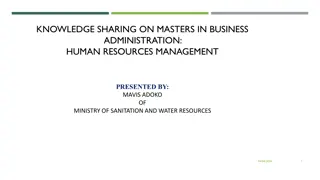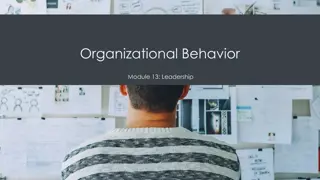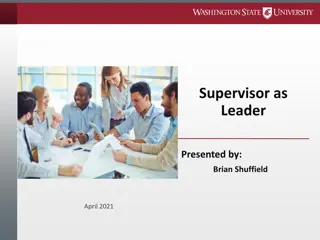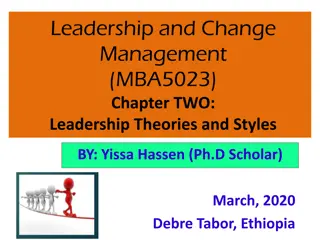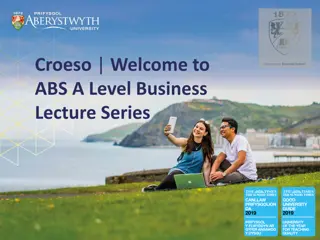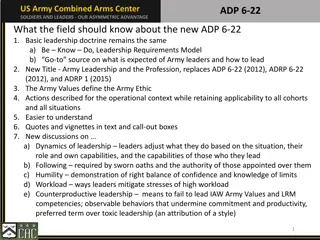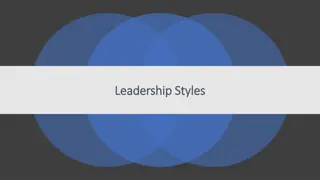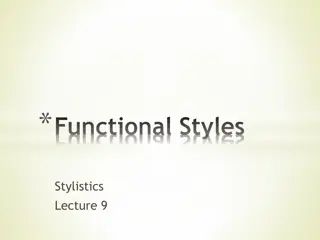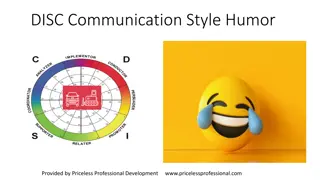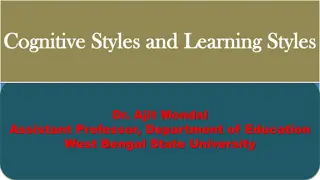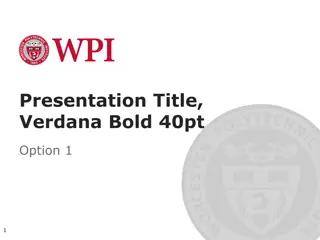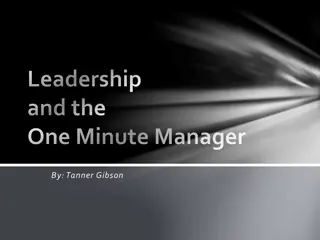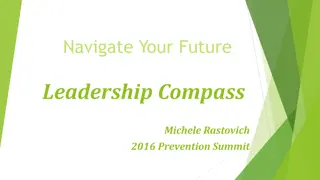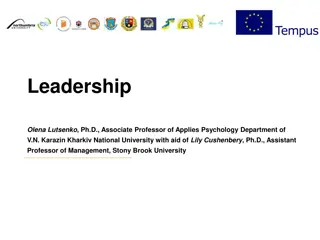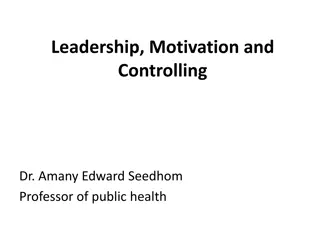
Understanding Different Leadership Styles for Effective Management
Explore various leadership styles including Transactional, Democratic, Autocratic, and Transformational, and how they impact employee motivation and organizational success. Learn how to develop transformational leadership skills for effective engagement and leadership.
Download Presentation

Please find below an Image/Link to download the presentation.
The content on the website is provided AS IS for your information and personal use only. It may not be sold, licensed, or shared on other websites without obtaining consent from the author. If you encounter any issues during the download, it is possible that the publisher has removed the file from their server.
You are allowed to download the files provided on this website for personal or commercial use, subject to the condition that they are used lawfully. All files are the property of their respective owners.
The content on the website is provided AS IS for your information and personal use only. It may not be sold, licensed, or shared on other websites without obtaining consent from the author.
E N D
Presentation Transcript
Leadership Styles Indiana University of Pennsylvania June 5, 2025 Dr. Del Hart
Leadership Styles a few Transactional Leadership Democratic Leadership Autocratic Leadership Transformational Leadership
Transactional Leadership Employees are motivated by leadership that embraces clear and consistent goal-setting, rewards, and punishments. **Transactional Leadership in Banking the leader works with personnel to convey clear quarterly targets, meet compliance standards, and maintain operational efficiency (a favorable profit/loss basis).
Democratic Leadership Employees are motivated by leadership that includes them in decision-making and operational procedures. **Democratic Leadership in Banking the leader encourages open communication, diverse viewpoints, and individuality when building consensus.
Autocratic Leadership Employees are motivated by leadership that makes decisions independently and rarely seeks their input. **Autocratic Leadership in Banking the leader makes decisions quickly and decisively, expects achievement of quarterly and organizational goals, and is not interested in the opinions and viewpoints of employees.
Transformational Leadership Employees are motivated by leadership that inspires and engages them in the organizational vision. **Transformational Leadership in Banking the leader empowers employees to provide innovative customer service procedures, to create improved methods of achieving goals, and to embrace positive change within the organization.
Developing Transformational, Effective Leadership The Single Most Important Principle Engagement Get Out Of The Office!
Developing Transformational, Effective Leadership The Leader s Foundation Always remember your roots and humble beginnings as an employee. Wisely use your time for the benefit of your audience in the organization. Who is the audience?
Engagement -The Leaders Checklist 1. Does the organization excel in its mission? 2. In the thoughts of the clients/customers, does the organization exemplify excellence? 3. Does the organization inspire its stakeholders to invest in it (trust)?
Engagement -The Leaders Checklist 4. Do you sincerely seek to develop, motivate, inspire, and encourage your audience? 5. Do you interact with your audience? Is your door open or shut for the majority of each day? 6. Have you organized advisory/project teams?
Developing Transformational, Effective Leadership How Well Do You Know Your Employees? 1. List the single most important organizational gripe of your employees. 2. List two employees that have expressed an interest in leadership positions.
Developing Transformational, Effective Leadership How Well Do You Know Your Employees? 3. List two employees that are regarded as outstanding by their peers. 4. List a significant life event that has occurred in the lives of two employees recently.
Transformational, Effective Leaders - Characteristics 1. Articulate an empowering vision. 2. Execute daily decisions that advance the vision.
Transformational, Effective Leaders - Characteristics 3. Exhibit a positive, optimistic outlook. 4. Victoriously live, each day, as a role model for others.
Vision Statements -Examples Preserving the Integrity of our Customers. Character Counts. Investing in America s Future. Enriching Our Communities. For the Trust of Our Customers. Empowering the Next Generation. Crafting the Best Services for Investors.
Best Practices of Effective Leaders 1. Define your audience leaders are always on-stage (role model) a. Regular displays of appreciation to the audience b. Language/actions that are important to the audience (not to the leader) asking questions c. Sincerity on stage
Best Practices of Effective Leaders 2. Attitude a. Overwhelming storms will occur. b. Prior preparation is paramount. c. Quiet courage + Prior preparation = success. (remember, you are on stage)
Best Practices of Effective Leaders 3. Behavior lead from the front. a. Roll-up your shirt sleeves and work with your audience in the trenches; i.e., their daily assignments. b. Urgent vs. important. (remember, you are on stage)
Best Practices of Effective Leaders 4. The Leader s organizational commitment vs. the Audience s perception of the Leader s organizational commitment. (remember, you are on stage)
Breakout Session The List Respect Video Clip: https://www.youtube.com/watch?v=3X81np_9QlE
Get Out of the Office (GOOTO) Practical applications: 1. Establish a vision very brief, that will empower your audience. 2. Follow through on your words and the vision, as you engage your audience make decisions on their turf in the community
Get Out of the Office (GOOTO) Practical applications: 3. Be visible each day engage the audience. 4. Interact, in person (talk to them) with your audience engage the audience.
Get Out of the Office (GOOTO) Practical applications: 5. Visit work stations each day engage the audience. 6. Assist (briefly, etc.) with duty assignments engage the audience.
Get Out of the Office (GOOTO) Practical applications: 7. Solve a major gripe of the audience. 8. Establish Employee Advisory/Project Teams.
Get Out of the Office (GOOTO) Practical applications: 9. Respect your employees time. A primary error of ineffective leaders is: the only important meetings are lengthy. 10.Support your audience (irate customers, questions of customers, organizational guidelines and regulations).
Get Out of the Office (GOOTO) Practical applications: 11. Care deeply for the audience and the organization engage the audience. 12. Remember your time in the trenches, before making decisions.
Get Out of the Office (GOOTO) Practical applications: 13. Except for sensitive conversations, open your office door, for the majority of each day. 14. Be in a good mood each day.
Contact Information: Dr. Del Hart dhart@iup.edu 717-363-0887

